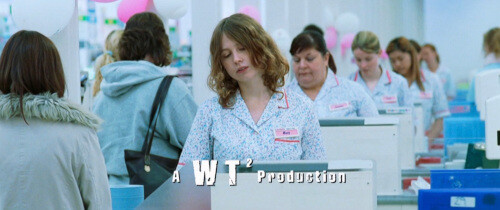‘Shaun of the Dead’ is About the Horrors of Customer Service

There have been a lot of zombie-themed comedies over the years, from Dead Alive to My Boyfriend’s Back to Weekend at Bernie’s II (Google it, it counts). But arguably the best of the bunch is Edgar Wright and Simon Pegg’s acclaimed 2004 horror-comedy Shaun of the Dead, which pretty much everyone on the planet adores – unless you hate zombie movies and/or happen to be ‘80s recording artist Sade.
A big reason why Shaun of the Dead works so goddamn well is that it contains moments of genuine horror; not just the gory grotesqueries of fighting against a full-blown zombie apocalypse, but also the abject unpleasantness of working in the customer service industry – a theme that we imagine has resonated with a ton of audience members. Yes, in Shaun of the Dead, the real horror isn’t being disemboweled, it’s working a brain-meltingly menial job for little-to-no money.
Don't Miss
The movie calls its thematic shot pretty overtly from the jump, showcasing how much of the world is already locked into a pattern of zombie-like behavior during the opening credits; be it grocery store employees serving the public, office workers waiting for the bus, or teens shuffling through the streets listening to … whatever it was British teenagers were listening to in 2004.
And Shaun, too, is working in customer service, half-heartedly selling TVs in a crappy electronics store, along with a staff seemingly comprised entirely of identically-dressed teenagers. Thanks to the burgeoning zombie plague, Shaun has been put in a position of modest responsibility for one day – not because he’s advanced within the store’s professional hierarchy at all, but just because everyone else is out sick and he’s the “oldest” employee.

Universal
The very first scene in the movie finds Shaun, Liz, and the gang at the Winchester pub, his contentious regular hang-out. The pub isn’t just Shaun’s go-to spot, it’s specifically where he kicks back after work, as evidenced by the fact that Shaun is still wearing his work clothes; the short-sleeved, white-collared shirt and red tie that serve as the uniform for Foree Electronics (named after Ken Foree who played Peter in Dawn of the Dead). As many of us who have worked in customer service can attest, getting drunk after a day of putting up with strangers’ crap is not exactly an uncommon occurrence.
This also informs Shaun’s plan to ride out the zombie outbreak at the Winchester because that’s how he has always coped in the past – and, importantly, Shaun’s plan doesn’t work. Several of his friends die, and the bar burns down because holing up in a pub isn't a sustainable or healthy way to deal with stress.
Importantly, once the zombie plot kicks in, Shaun spends the entire movie wearing his uniform, as if he is branded and defined by his role as the aging lifer at an electronics store. Earlier drafts of the screenplay made this even more apparent; originally, when Shaun runs into Yvonne, she remarks that she hasn’t seen him since he was working at “that bloody electrical place” before noticing his name tag and realizing “her faux pas.”

Universal
But, as Shaun becomes more decisive and take charge throughout the movie, he slowly begins to shed pieces of his uniform; first, his name tag disappears, and later his red tie becomes a bad-ass bandana.
Even more pointed is the depiction of the zombies; clearly, many of these undead ghouls represent Shaun’s internal struggles. Sometimes this is very literal (like with his mom, roommate, and step-dad), while in other cases, it’s much more symbolic – like when the commitment-challenged Shaun is literally terrorized by a zombie groom.

Universal
And a lot of the zombies are, themselves, people who work in customer service. It’s likely no coincidence that the first zombie Shaun and Ed encounter is Mary, the grocery store clerk we saw briefly in the opening credits. Not unlike Shaun, she too is still wearing her uniform and name tag.

Universal

Universal
It’s not just Mary, there’s also the bartender and Nelson, the convenience store clerk. The movie repeatedly goes out of its way to show us that the transition from customer service to zombism is a somewhat lateral move, not just with the opening credits, but even when the zombie outbreak is in full swing, Shaun doesn’t notice that anything has changed.
Then, at the very end of the film, we learn that the zombies’ continued motor skills and lack of brain function make them “ideal recruitment for the service industry.” We even see that Noel, Shaun’s phone-loving 17-year-old co-worker, is now one of the zombies being exploited by corporate interests, and is “working” as a grocery store attendant, complete with a blue smock and, of course, a name tag. While obviously funny, this quick joke also makes the film’s theme very explicit: Shaun escaping the zombie horde also meant Shaun escaping the service industry.
In a way, this isn’t wholly dissimilar from the satirical elements of Shaun of the Dead’s key influence and namesake. George A. Romero’s shopping mall-set Dawn of the Dead was an unsubtle takedown of mindless consumerism. The zombies are drawn to the mall as if by instinct because, as our protagonists speculate, it was “an important place in their lives.”
But while Romero’s film is ultimately a bird’s eye view of the horrors of consumer culture, Shaun of the Dead is about the horror of actually working as complicit pawns who further the machinations of said consumer culture … but with zombies.
You (yes, you) should follow JM on Twitter!
Thumbnail: Universal
